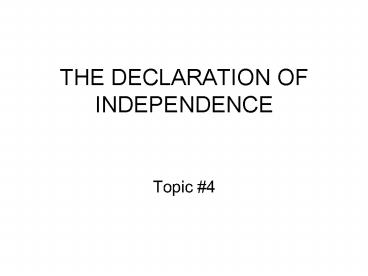THE DECLARATION OF INDEPENDENCE - PowerPoint PPT Presentation
Title:
THE DECLARATION OF INDEPENDENCE
Description:
THE DECLARATION OF INDEPENDENCE Topic #4 Historical Circumstances The Continental Congresses were ad hoc meetings of delegates from each of the several American ... – PowerPoint PPT presentation
Number of Views:53
Avg rating:3.0/5.0
Title: THE DECLARATION OF INDEPENDENCE
1
THE DECLARATION OF INDEPENDENCE
- Topic 4
2
Historical Circumstances
- The Continental Congresses were ad hoc meetings
of delegates from each of the several American
colonies to deliberate on matters of common
concern. - The First Continental Congress met in 1774.
- The Second Continental Congress first met in
1775. - In 1776 it drafted and voted on the Declaration
of Independence. - Congress appointed a committee to draft such a
document. - John Adams was the chair of the committee and
Thomas Jefferson was a member. - Adams delegated to Jefferson the task of writing
a first draft. - Jeffersons draft was revised a bit in committee
and further revised by Congress as a whole. - The Declaration was enacted on July 4, 1776.
- Adams and Jefferson subsequently were estranged
due to political conflicts but reconciled later
in life. They both died on July 4, 1826. - The Second Continental Congress remained in
session until 1781 and organized the
revolutionary war effort against the British. - The British did find the Declaration entirely
persuasive.
3
Structure of Declaration
- Preamble When in the course of human events, it
becomes necessary for one people to dissolve the
political bands which have connected them with
another, and to assume among the powers of the
earth, the separate and equal station to which
the Laws of Nature and of Nature's God entitle
them, a decent respect to the opinions of mankind
requires that they should declare the causes
which impel them to the separation. - Statement of Political Philosophy We hold these
truths to be self-evident - that all men are created equal,
- that they are endowed by their Creator with
certain unalienable Rights, - that among these are Life, Liberty and the
pursuit of Happiness. - that to secure these rights, Governments are
instituted among Men, deriving their just powers
from the consent of the governed, - that whenever any Form of Government becomes
destructive of these ends, it is the Right of the
People to alter or to abolish it, and to
institute new Government, laying its foundation
on such principles and organizing its powers in
such form, as to them shall seem most likely to
effect their Safety and Happiness.
4
Structure of Declaration (cont.)
- Charges against the King The history of the
present King of Great Britain George III is a
history of repeated injuries and usurpations, all
having in direct object the establishment of an
absolute Tyranny over these States. To prove
this, let Facts be submitted to a candid world. - 27 specific charges taking up about 75 of the
document - Conclusion In every stage of these Oppressions
We have Petitioned for Redress in the most humble
terms Our repeated Petitions have been answered
only by repeated injury. A Prince whose character
is thus marked by every act which may define a
Tyrant, is unfit to be the ruler of a free
people. . . . They too have been deaf to the
voice of justice and of consanguinity. We,
therefore, the Representatives of the united
States of America, in General Congress,
Assembled, . . . solemnly publish and declare,
That these United Colonies are, and of Right
ought to be Free and Independent States. . . .
5
The Logic of the Declaration
- The Declaration does not specify a proper form of
government. The (logically interconnected)
criteria for judging whether a government is
normatively legitimate or not are - whether it is based on the consent of the
governed, and - whether it acts to secure peoples natural
rights. - Therefore, the Declaration does not condemn
monarchy per se. - Otherwise, a Prince of any character could
never be the ruler of a free people, and - there would be no need to come up with 27 charges
against the King. - Also, the Declaration can be used to condemn a
democratic governments that abridges, rather than
secures, natural rights. - Whenever any Form of Government becomes
destructive of these ends, it is the Right of the
People to alter or to abolish it.





![Download [PDF] Our Declaration: A Reading of the Declaration of Independence in Defense of PowerPoint PPT Presentation](https://s3.amazonaws.com/images.powershow.com/10110245.th0.jpg?_=20240826052)
![Download [PDF] Our Declaration: A Reading of the Declaration of Independence in Defense of PowerPoint PPT Presentation](https://s3.amazonaws.com/images.powershow.com/10108837.th0.jpg?_=20240825057)
![Download [PDF] Our Declaration: A Reading of the Declaration of Independence in Defense of PowerPoint PPT Presentation](https://s3.amazonaws.com/images.powershow.com/10107505.th0.jpg?_=20240824096)























